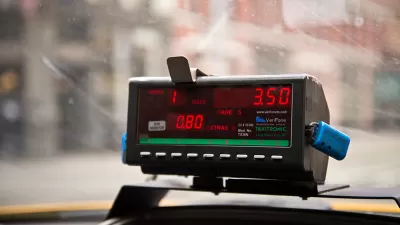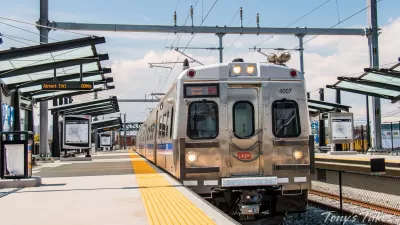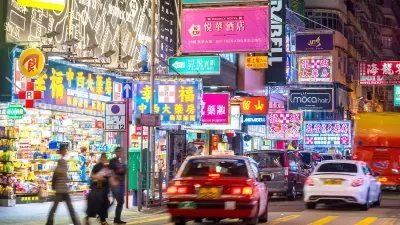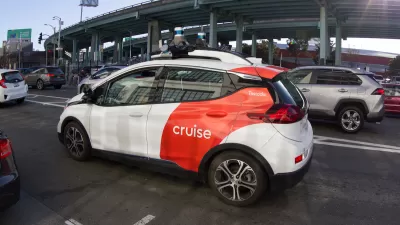Taxis, including new ride hailing services, play unique and important roles in an efficient and equitable transport systems. Let's support them with smart policies.

When people hear that our family is car-free, many seem to consider this a judgement on their car-dependent lifestyle, and so use examples, such shopping or attending late-night events, to justify owning a vehicle. However, there is an easy solution to this problem: taxis and ride-hailing services such as Uber and Lyft.
Taxis are an important component of an efficient and equitable transportation system; they provide basic mobility for people who cannot drive, and are for many households are more affordable than car ownership. Taxi fares typically average $2.00-3.00 per mile, so it is cheaper to take 10-15 weekly taxi trips in urban areas where trips average 5 miles, or 5-10 weekly taxi trips in suburban areas where trips average 10 miles in length, than to spend $100 to $150 per week on a private car. Although car-free households rely mostly on walking, cycling, and public transit, taxis play a critical role by serving trips unsuited to those modes.
Automobiles have an inefficient price structure: they are costly to own but relatively cheap to drive. This encourages vehicle owners to maximize their mileage in order to get their money's worth from their large fixed costs, and for many local trips, driving costs less than transit fares. Only if households have many travel options that serve diverse demands can they reduce their vehicle ownership, for example, from two to one, or one to zero vehicles, and thus achieve large savings and vehicle-travel reduction benefits.
However, the taxi industry faces significant challenges that reduce its potential benefits. Most jurisdictions limit the number of taxis licenses (sometimes called medallions, because some cities issued metal plaques rather than pieces of paper) issued. Although this was intended to ensure fair drivers’ wages, the value became capitalized into the licenses, which now cost $200,000 to $800,000 in many cities. Because licenses are issued to vehicles, there is no practical way to deploy additional vehicles when they are needed most, for example, on weekends. Servicing these costs adds $10,000-$40,000 annually, or $25-$100 per day, to cab operating costs, driving up fares.
Ride hailing services (also called App Based Service Models) are trying to circumvent these regulations by claiming to be something other than a taxi. From users' perspective they are essentially the same, but generally more convenient, due to automation, more responsive, since they can deploy additional vehicles during peak periods, and 20-40 percent cheaper because they have lower costs and regulations. I support their expansion as a way to improve service and reduce prices, but I believe it is important to do so cautiously, to maximize efficiency and service quality.
Taxi drivers fear that they will lose their jobs, although I suspect that many will benefit as the total taxi demand increases, causing conventional and new taxi companies to compete even more for experienced drivers. The big losers will be the license owners who are likely to see the value of their investments decline rapidly during the next few years.
On the other hand, I suspect that most Uber and Lyft drivers are earning significantly less than those companies claim, and I hope that those companies change their price structures to better support drivers, or at least provide more realistic information about drivers' net incomes. One Wall Street Journal article claimed that a typical Uber driver grosses more than $100,000 annually and earns more than $13 per hour in net income, almost twice typical U.S. minimum wages, but Uber used optimistic assumptions in its calculations, including a $16,000 vehicle (new vehicles actually average about twice that), 6.4 cents per mile depreciation (about half the real amount), $1.75 per gallon gasoline (regular fuel currently averages over $2.00 per gallon, and more in major cities were ride-hailing services are concentrated), and no accounting for deadhead (unpaid vehicle-miles to pick up and after dropping off passengers) vehicle expenses. According to recent Buzzfeed News analysis, Uber driver incomes actually range from $8.77 an hour in Detroit, $10.75 in Houston, and $13.17 in Colorado, and even these are probably exaggerated because they underestimate total vehicle costs.
Motor vehicles experience significant mileage-based depreciate: the more it is driven the more frequent it will need repairs, the less it is worth, and the sooner it will be junked. According to analysis illustrated below, 90,000 miles reduces a vehicle's value by about 35 percent. For a vehicle that cost $32,000 new, this averages about 12 cents per mile driven. In addition, each additional mile driven increases the chances of an accident or scratch, or a traffic or parking citation, which can add hundred dollars to the annual costs of driving.

Consider a typical example. Let's say you spend $32,000 to purchase a nice car or SUV, with the expectation that you can earn a decent living with Uber. On average, you drive 200 miles during 250 annual Uber workdays, or 50,000 miles per year, and you average two $500 crashes plus five $100 tickets annually. This totals $6,000 (50,000 x $0.12) in mileage-based depreciation, $1,000 in repairs, and $500 in tickets, totalling $3.00 per Uber hour. Had you only driven the vehicle for personal use, after three years and 30,000 miles you would have received $22,000 in trade-in value, but with 180,000 miles on the odometer and lots of visible wear, the car is worth only $8,400. These extra costs reduce Uber’s claimed $13 per hour net income by 23 percent, to $10, which is still more than minimum wage in most jurisdictions, but not much. This is not to suggest that Uber is abusing drivers and should be discouraged, but everybody involved needs realistic information concerning the actual incomes provided by existing and new transportation services.
These are important, emerging issues for policy makers, taxi drivers and consumers. Here are some key conclusions concerning smart policies for more efficient and responsive taxi services:
- Vehicles-for-hire, including taxis and ride hailing services, play important roles in an efficient and equitable transportation system.
- They should be regulated to ensure service quality and safety.
- Supply limits are often counter-productive because the value tends to be capitalized into licenses, driving up fares.
- Ride haling can offer new and valuable services, and a flexible supply that addresses vehicle-for-hire shortages during peak load hours, features that could be offered by traditional taxi companies if they had more flexible regulations concerning fare structures and part-time operators.
Information Resources
Bruce Brown (2016), How Much Do Uber Drivers Really Make?, Digital Trends.
Competition Bureau (2015), Modernizing Regulation in The Canadian Taxi Industry, Government of Canada.
Data Team (2015), Taxis v Uber: Substitutes or Complements?, The Economist
Hara Associates (2015), Taxi and Limousine Regulations and Service Review Taxi Economics – Old and New, City of Ottawa.
Nelson\Nygaard (2013), Taxi Consultant Report, City of Boston.
Brishen Rogers (2015), The Social Costs of Uber, University of Chicago Law Review.
Bruce Schaller (2015), Taxi, Sedan, and Limousine Industries and Regulations, Transportation Research Board Committee for Study of Innovative Urban Mobility Services.
Jeremy Singer-Vine and Caroline O'Donovan (2016), Methodology For Estimating Uber Drivers’ Hourly Net Earnings, BuzzFeed News.
Taxi and Limousine Commission (2014), Taxi Cab Factbook, New York City.

Alabama: Trump Terminates Settlements for Black Communities Harmed By Raw Sewage
Trump deemed the landmark civil rights agreement “illegal DEI and environmental justice policy.”

Study: Maui’s Plan to Convert Vacation Rentals to Long-Term Housing Could Cause Nearly $1 Billion Economic Loss
The plan would reduce visitor accommodation by 25% resulting in 1,900 jobs lost.

Planetizen Federal Action Tracker
A weekly monitor of how Trump’s orders and actions are impacting planners and planning in America.

Study Links Covid and Poor Driving
The effects of the virus, including ‘brain fog,’ can make driving more difficult and dangerous.

Waymo Gets Permission to Map SF’s Market Street
If allowed to operate on the traffic-restricted street, Waymo’s autonomous taxis would have a leg up over ride-hailing competitors — and counter the city’s efforts to grow bike and pedestrian on the thoroughfare.

Parklet Symposium Highlights the Success of Shared Spaces
Parklets got a boost during the Covid-19 pandemic, when the concept was translated to outdoor dining programs that offered restaurants a lifeline during the shutdown.
Urban Design for Planners 1: Software Tools
This six-course series explores essential urban design concepts using open source software and equips planners with the tools they need to participate fully in the urban design process.
Planning for Universal Design
Learn the tools for implementing Universal Design in planning regulations.
Caltrans
Smith Gee Studio
Institute for Housing and Urban Development Studies (IHS)
City of Grandview
Harvard GSD Executive Education
Toledo-Lucas County Plan Commissions
Salt Lake City
NYU Wagner Graduate School of Public Service






























